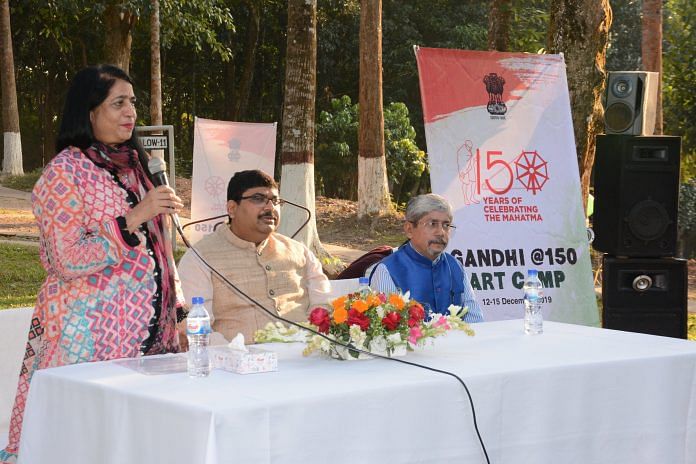New Delhi: Last week, 63-year-old international award-winning Bangladeshi artist Rokeya Sultana was gearing up for a solo art exhibition in India from 23 October to 11 December. The exhibition, planned as a joint collaboration between the Indian Council for Cultural Relations and Dhaka-based non-profit Bengal Foundation, was meant to display 120 to 130 pieces of the artist’s work.
A printmaker and painter, Sultana also serves as Chairman of the Faculty of Fine Art at Dhaka University.
In light of the Durga Puja communal violence in Bangladesh against the country’s Hindu minority, however, the Indian government decided to postpone her exhibition indefinitely, reported ThePrint earlier this week.
Though Sultana has exhibited in India before, the now-cancelled event was meant to show the full breadth of her work over forty-odd years. The cancellation of the exhibition has come as a shock to her peers in Dhaka University as well as other prominent figures in the country’s art community.
Speaking to ThePrint, Bangladeshi photographer Abir Abdullah, whose work has been published in publications like The New York Times, Der Spiegel and The Guardian, reacted by saying: “This is definitely shocking to hear. No artists from any country should be restricted in showing their works or practicing freedom of expression. Why should they be blamed for others’ misdeeds?”
Meanwhile, Shishir Bhattacharjee, Professor of Fine Art at Dhaka University, had a more pragmatic view. “Rokeya, nicknamed ‘Lovely’ by some of us at the university, is a talented artist. But sometimes, the consequences of political turmoil and foreign relations are outside an artist’s control,” he told ThePrint.
He explained that Bangladeshi artists have long faced restrictions within their own country. “I used to draw political cartoons for newspapers but I stopped after 2017, when broad media laws were introduced in Bangladesh. Artists have been under suppression due to laws like Section 57 of the Information and Communication Technology (ICT) Act.”
Many journalists, artists and activists have faced the brunt of the ICT Act, including renowned photographer Shahidul Alam, whose arrest in 2019 for comments on student protests, sparked global outrage.
Also read: And, cut! — Modi govt’s new cinema bill a ‘super censor’. And Netflix no longer an oasis
The ‘art’ of Sultana
Sultana is best known for playing with themes of womanhood, sensuality and feminism. Her figural series ‘Madonna’ and ‘Relations’ are the most popular, as well as print series ‘Fata Morgana’.
In the ‘Madonna’ series, named after the American pop legend, Sultana depicts the everyday woman navigating the world. She had once explained, in an interview to Daily Star, that the woman in her work is always in a magenta sari to show she’s traditional but rebellious underneath.
“The colour, magenta, is a symbol of transforming negativity through the feminine psyche. Magenta is on the verge of being an aggressive form of red, but it is softer, more playful and more positive,” explained Sultana. “Madonna’ is every girl and every woman”.
The ‘Fata Morgana’ series — which comes from the word denoting a type of ocean mirage — featured 40 abstract and semi-abstract artworks. Unlike the ‘Madonna’ series, which had a clear cut story, this one played with the idea of distortions. It involved several colourful multi-layer prints achieved through a tedious woodcut and pressure-point technique of printmaking.
She has exhibited her works across countries such as Denmark, Egypt, Turkey, Taiwan, Nepal, Korea, France, Iran, Jordan, and Pakistan at centres like Australia’s Blacktown Arts Centre and Bangladesh’s Bengal Gallery of Fine Arts.
Sultana has won several awards and scholarships, including a 2012 prestigious Fullbright grant for a 9-month artist’s residency at the University of Nebraska-Lincoln. It was there that she learnt the pressure print technique used in the ‘Fata Morgana’ series.
In the past, Sultana’s works have sold at auctions with prices ranging from approximately Rs 9,000 to Rs 80,000 ($122 – $1,162). She continues to be an influential figure in Bangladesh’s art community. “I never missed her exhibitions. They were so different and unique,” Abdullah told ThePrint.
Also read: Liberal intellectuals lack popular political language against Hindutva. That’s just lazy
Growing up in political turmoil
Sultana was born in Chittagong in 1958 at a time when the country was still considered East Pakistan. It would only gain independence thirteen years later in 1971. She was “influenced by the tumultuous 1971 revolution that created Bangladesh,” according to the Bengal Foundation.
Sultana graduated from the Bangladesh College of Arts and Crafts in Dhaka in 1980 and received a master’s degree in printmaking from Visva Bharati, Santiniketan in India three years later. Legendary artists Safiuddin Ahmed and Mohammad Kibria were among her mentors.
She is married to former Bangladeshi cricketer Omar Khaled Rumi, and flits between her studios in Sydney and Dhaka. Rumi, apart from being one of Bangladesh’s top order batsmen, was also a musician at one point in his career.
Together, the couple have a daughter named Fariba, who is also a musician. In a 2007 interview to Daily Star, Fariba recalled composing a song that her mother had written in memory of her late mother. “My grandmother died last year [2006] and I know how painful it was for my mother to write this song. When she asked me to compose it, I was very nervous and spent a long time working on this particular number,” said Fariba.
On 7 October this year, Sultana’s works were launched at an exhibition at the Indian Cultural Centre, Gulshan in Dhaka. The event was meant to be a curtain raiser for her first standalone show in India, which now stands cancelled.



